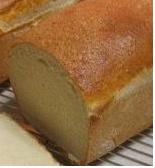Manchet
Manchet[edit | edit source]
A manchet is a type of bread that was popular in England during the Tudor period and Stuart period. It is known for its fine, white crumb and was considered a high-quality bread, often consumed by the upper classes. The manchet is similar to modern bread rolls but was typically larger and rounder.
History[edit | edit source]
The manchet has its origins in the Middle Ages, where it was a staple in the diet of the wealthy. It was made from the finest wheat flour, which was sifted to remove the bran and produce a white, soft texture. This made it more expensive than other types of bread, such as rye bread or wholemeal bread, which were consumed by the lower classes.
During the Elizabethan era, the manchet became a symbol of status and refinement. It was often served at banquets and special occasions. The recipe for manchet was included in several early cookbooks, such as "The Good Huswifes Handmaide for the Kitchin" published in 1594.
Preparation[edit | edit source]
To make a traditional manchet, bakers would use a mixture of fine wheat flour, water, yeast, and a small amount of salt. The dough was kneaded thoroughly to develop the gluten, which gave the bread its characteristic texture. After kneading, the dough was left to rise before being shaped into round loaves and baked in a hot oven.
The baking process was crucial to achieving the desired crust and crumb. Manchets were often baked in a wood-fired oven, which imparted a unique flavor to the bread.
Cultural Significance[edit | edit source]
The manchet was more than just a type of bread; it was a cultural icon in Renaissance England. It represented the wealth and sophistication of those who could afford to eat it. The term "manchet" itself became synonymous with quality and luxury in the context of food.
In literature, the manchet is often mentioned as a delicacy enjoyed by the nobility. It is referenced in the works of William Shakespeare and other contemporary writers, highlighting its prominence in the diet of the time.
Modern Variations[edit | edit source]
Today, the manchet is not as commonly found as it once was, but it has inspired various modern bread recipes. Bakers who wish to recreate the traditional manchet often experiment with different types of flour and baking techniques to achieve a similar texture and flavor.
Related pages[edit | edit source]
Search WikiMD
Ad.Tired of being Overweight? Try W8MD's NYC physician weight loss.
Semaglutide (Ozempic / Wegovy and Tirzepatide (Mounjaro / Zepbound) available. Call 718 946 5500.
Advertise on WikiMD
|
WikiMD's Wellness Encyclopedia |
| Let Food Be Thy Medicine Medicine Thy Food - Hippocrates |
Translate this page: - East Asian
中文,
日本,
한국어,
South Asian
हिन्दी,
தமிழ்,
తెలుగు,
Urdu,
ಕನ್ನಡ,
Southeast Asian
Indonesian,
Vietnamese,
Thai,
မြန်မာဘာသာ,
বাংলা
European
español,
Deutsch,
français,
Greek,
português do Brasil,
polski,
română,
русский,
Nederlands,
norsk,
svenska,
suomi,
Italian
Middle Eastern & African
عربى,
Turkish,
Persian,
Hebrew,
Afrikaans,
isiZulu,
Kiswahili,
Other
Bulgarian,
Hungarian,
Czech,
Swedish,
മലയാളം,
मराठी,
ਪੰਜਾਬੀ,
ગુજરાતી,
Portuguese,
Ukrainian
Medical Disclaimer: WikiMD is not a substitute for professional medical advice. The information on WikiMD is provided as an information resource only, may be incorrect, outdated or misleading, and is not to be used or relied on for any diagnostic or treatment purposes. Please consult your health care provider before making any healthcare decisions or for guidance about a specific medical condition. WikiMD expressly disclaims responsibility, and shall have no liability, for any damages, loss, injury, or liability whatsoever suffered as a result of your reliance on the information contained in this site. By visiting this site you agree to the foregoing terms and conditions, which may from time to time be changed or supplemented by WikiMD. If you do not agree to the foregoing terms and conditions, you should not enter or use this site. See full disclaimer.
Credits:Most images are courtesy of Wikimedia commons, and templates, categories Wikipedia, licensed under CC BY SA or similar.
Contributors: Prab R. Tumpati, MD

